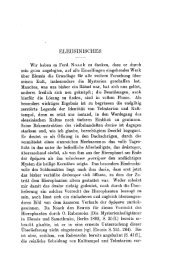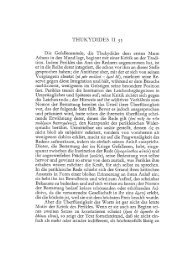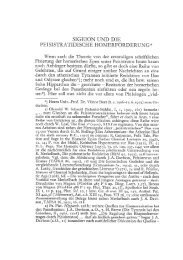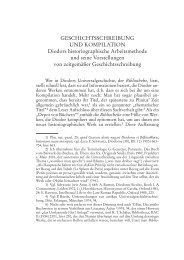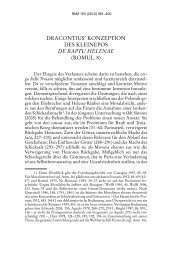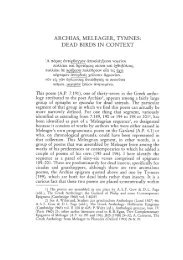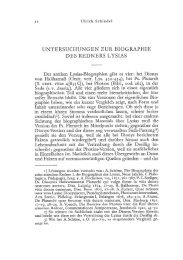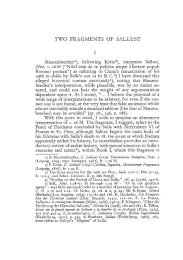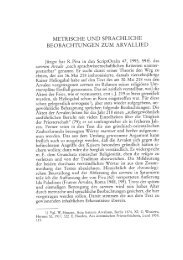APOTELESMATICA 2. (1) 14–140: SOURCES AND MODELS*
APOTELESMATICA 2. (1) 14–140: SOURCES AND MODELS*
APOTELESMATICA 2. (1) 14–140: SOURCES AND MODELS*
You also want an ePaper? Increase the reach of your titles
YUMPU automatically turns print PDFs into web optimized ePapers that Google loves.
88 Maria Ypsilanti<br />
The influence of Aratus on the level of poetry:<br />
concept, images, vocabulary<br />
The principal technique in which the author of the Apotelesmatica<br />
uses the Phaenomena is generally variation and imitation by<br />
contrast, manifest throughout the lines in which there is reference<br />
to Aratus. As will be shown, Pseudo-Manetho’s play with Aratus<br />
on the level of expression is evident in the lines under discussion in<br />
which, as we have seen, the Hellenistic poet is also used on the level<br />
of content.<br />
The author of the Apotelesmatica does the exact opposite of<br />
what Aratus did; the Hellenistic poet referred briefly to the five<br />
planets (Hermes, Aphrodite, Ares, Zeus, Cronus), “for the sake of<br />
completeness”, 47 devoting his poem to the fixed stars and their significance<br />
for the weather; Pseudo-Manetho, on the contrary, refers<br />
briefly to the fixed stars, also for the sake of completeness, one can<br />
indeed remark, his main theme being the five planets themselves.<br />
The author presents his subject in the opening of the Apotelesmatica<br />
(<strong>2.</strong> [1] 14–17) imitating Aratus in opposition, as his image<br />
echoes the relevant Aratean passage and is directly opposite in<br />
purpose:<br />
Ofl dÉ §pim‹j êlloi p°ntÉ ést°rew oÈd¢n ımo›oi<br />
pãntoyen efid≈lvn duoka¤deka dineÊontai.<br />
OÈk ín tÉ efiw êllouw ırÒvn §pitekmÆraio<br />
ke¤nvn ∏xi k°ontai, §pe‹ pãntew metanãstai.<br />
...<br />
OÈdÉ ti yarsal°ow ke¤nvn §g≈: êrkiow e‡hn<br />
éplan°vn tã te kÊkla tã tÉ afiy°ri sÆmatÉ §nispe›n.<br />
(Arat. 454–7, 460–1)<br />
But there are five other stars among them, but quite unlike them, that<br />
circulate all the way through the twelve figures of the zodiac. You cannot<br />
in this case identify where these lie by looking at other stars, for<br />
they all change positions (. . .). I am not at all confident in dealing with<br />
them: I hope I may be adequate in expounding the circles of the fixed<br />
stars and their constellations in the sky.<br />
Pseudo-Manetho presents the image of the planets wandering<br />
through the Zodiac in a condensed form, by comparison with his<br />
model, and comes to the opposite conclusion: these five planets are<br />
exactly the subject of his poem. On 455 (pãntoyen . . . dineÊontai)<br />
47) Kidd 343.



